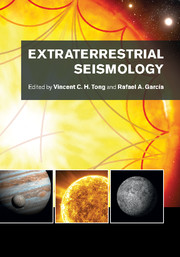Book contents
- Frontmatter
- Contents
- List of contributors
- Preface
- Acknowledgements
- List of abbreviations
- Planetary seismology: High risk, high return
- A bright outlook for helio- and asteroseismology
- Part I Observation and space missions
- Part II Data and physical parameters
- 4 Asteroseismology: From the telescope to the modeler's desk
- 5 Global helioseismology and asteroseismology of solar-type stars
- 6 Measurements with local helioseismology
- 7 Planetary seismology: Early observational results
- Part III Modeling approaches
- Part IV Discoveries of physical structures and processes
- Part V Interdisciplinary research involving planetary and astrophysical sciences
- Part VI Interdisciplinary research involving terrestrial seismology
- References
- Index
4 - Asteroseismology: From the telescope to the modeler's desk
from Part II - Data and physical parameters
Published online by Cambridge University Press: 05 July 2015
- Frontmatter
- Contents
- List of contributors
- Preface
- Acknowledgements
- List of abbreviations
- Planetary seismology: High risk, high return
- A bright outlook for helio- and asteroseismology
- Part I Observation and space missions
- Part II Data and physical parameters
- 4 Asteroseismology: From the telescope to the modeler's desk
- 5 Global helioseismology and asteroseismology of solar-type stars
- 6 Measurements with local helioseismology
- 7 Planetary seismology: Early observational results
- Part III Modeling approaches
- Part IV Discoveries of physical structures and processes
- Part V Interdisciplinary research involving planetary and astrophysical sciences
- Part VI Interdisciplinary research involving terrestrial seismology
- References
- Index
Summary
In this chapter, I discuss the first steps in asteroseismic analysis – following data through the analysis to the products that are what stellar modeling tries to explain. For asteroseismology, the time-varying signal is generally either the total brightness of the target (i.e., time-series photometry) or the (disk-integrated) radial velocity as measured via Doppler shifts of spectral lines. In either case, we measure a differential quantity (ΔY/Y) at regular intervals. More precisely, this quantity is integrated over a finite but short time (shorter than any expected signal from the star), producing an average value over the time interval of the integration. This produces the time series of the signal which I refer to as yn (tn) not in an instantaneous sense, but in a smoothed way.
Our time series represents an averaged, discretely sampled quantity as a function of time. From that time series, our goal is to determine the harmonic content of the signal – over what time scale(s) does the signal vary? Are there coherent (in phase and/or amplitude) sinusoidal variations? Are there preferred time scales for “noise” processes? Are there periodicities whose phase varies slowly over the entire interval? Are there “temporary” periodic signals? Answering these questions requires more and more sophisticated analysis techniques. In all cases, though, the sampling of the signal is critical in limiting the information content that we can derive.
There are many tools and techniques available for analysis of time-series data. In this chapter I will concentrate on Fourier analysis (i.e., power spectrum analysis), and also describe least-squares fits to amplitudes, phases, and frequencies. An equivalent analysis is via the Lomb–Scargle periodogram (Scargle, 1982; Appourchaux, 2014). Of course, more sophisticated tools are available but these have provided the dominant “one-two” punch for most asteroseismic studies. Various specific applications of asteroseismology employ subsequent analysis of the power spectra or frequency lists to derive oscillation parameters, but I leave those to subsequent chapters.
- Type
- Chapter
- Information
- Extraterrestrial Seismology , pp. 51 - 62Publisher: Cambridge University PressPrint publication year: 2015



